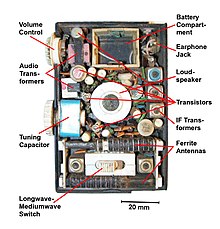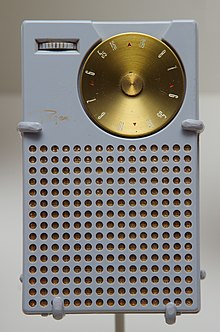TRANSISTOR RADIO
This article is about an electronic device. For the fourth studio album by M. Ward, see
A transistor radio is a small portable radio receiver using transistor-based circuitry. Following their development in 1954 they became the most popular electronic communication device in history, with billions manufactured during the 1960s and 1970s. Their pocket size sparked a change in popular music listening habits, for the first time allowing people to listen to music anywhere they went. In the 1970s their popularity declined as other portable media players such as boom boxes and portable cassette players took over. Contents |
Background
Bell Laboratories demonstrated the first transistor on December 23, 1947.[1] The scientific team at Bell Laboratories responsible for the solid-state amplifier included William Shockley, Walter Houser Brattain, and John Bardeen.[2] After obtaining patent protection, the company held a news conference on June 30, 1948, at which a prototype transistor radio was demonstrated.[3] There are many claimants to the title of the first company to produce practical transistor radios, often incorrectly attributed to Sony (originally Tokyo Tsushin Kogyo). Texas Instruments had demonstrated all-transistor AM (amplitude modulation) radios as early as 1952, but their performance was well below that of equivalent vacuum tube models. A workable all-transistor radio was demonstrated in August 1953 at the Düsseldorf Radio Fair by the German firm Intermetall. It was built with four of Intermetall's hand-made transistors, based upon the 1948 invention of Herbert Mataré and Heinrich Welker. However, as with the early Texas Instruments units (and others) only prototypes were ever built; it was never put into commercial production. RCA had demonstrated a prototype transistor radio as early as 1952 and it is likely that they and the other radio makers were planning transistor radios of their own, but Texas Instruments and Regency were the first to offer a production model.
Sanyo 8S-P3 transistor radio, which received AM and shortwave bands.
Listeners sometimes held an entire transistor radio directly against the side of the head, with the speaker against the ear, to minimize the "tinny" sound caused by the high resonant frequency of its small speaker enclosure. Most radios included earphone jacks and came with single earphones that provided only mediocre-quality sound reproduction. To consumers familiar with the earphone-listening experience of the transistor radio, the first Sony Walkman cassette player, with a pair of high-fidelity stereo earphones, would provide a greatly contrasting display of audio fidelity.
The transistor radio remains the single most popular communications device in existence. Some estimates suggest that there are at least seven billion of them in existence, almost all tunable to the common AM band, and an increasingly high percentage of those also tunable to the FM band. Some receive shortwave broadcasts as well. Most operate on battery power. They have become small and cheap due to improved electronics which has the ability to pack millions of transistors on one integrated circuit or chip. To the general public, the prefix "transistor" means a pocket radio; it can be used to refer to any small radio, but the term itself is now obsolete, since virtually all commercial broadcast receivers, pocket-sized or not, are now transistor-based. Regency TR-1 — the first transistor radio
Two companies working together, Texas Instruments of Dallas, Texas and Industrial Development Engineering Associates (I.D.E.A.) of Indianapolis, Indiana, were behind the unveiling of the Regency TR-1, the world's first commercially produced transistor radio. Previously, Texas Instruments was producing instrumentation for the oil industry and locating devices for the U.S. Navy, and I.D.E.A. built home television antenna boosters, but the two companies worked together on the TR-1, looking to grow revenues for their respective companies by breaking into this new product area.[3] In May 1954, Texas Instruments had designed and built a prototype and was looking for an established radio manufacturer to develop and market a radio using their transistors. None of the major radio makers including RCA, Philco, and Emerson were interested. The President of I.D.E.A. at the time, Ed Tudor, jumped at the opportunity to manufacture the TR-1, predicting sales of the transistor radios at "20 million radios in three years".[5] The Regency TR-1 was announced on October 18, 1954 by the Regency Division of I.D.E.A., was put on sale in November 1954, and was the first practical transistor radio made in any significant numbers. Billboard reported in 1954 that "the radio has only four transistors. One acts a combination mixer-oscillator, one as an audio amplifier, and two as intermediate-frequency amplifiers."[6] One year after the release of the TR-1 sales approached the 100,000 mark. The look and size of the TR-1 was well received, but the reviews of the TR-1's performance were typically adverse.[5] The Regency TR-1 is patented by Richard C. Koch, US 2892931, former Project Engineer of I.D.E.A.


Tidak ada komentar:
Posting Komentar